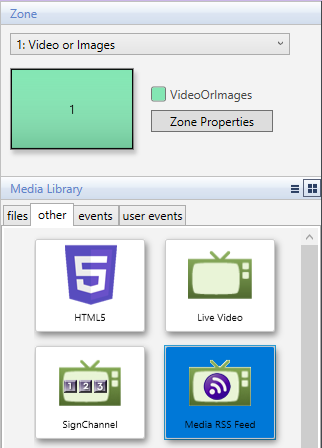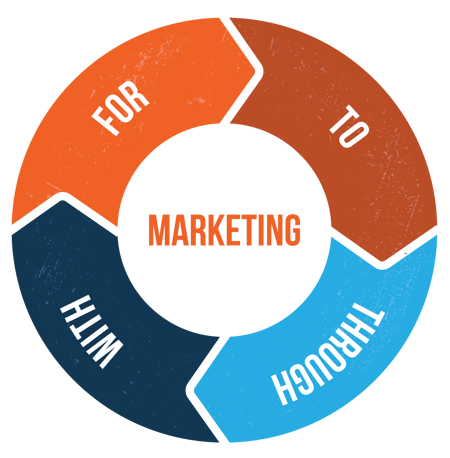
Marketing automation is a collection of tools and methods that eliminate repetitive, time consuming tasks. It's an effective way to implement your audience-nurturing strategy without consuming your team’s time or resources. You can automate these tasks and focus your attention on the more important, hands-on marketing that demands your undivided commitment. Marketing automation allows you to personalize customer experiences beyond just adding a person's name in the subject line. You can automatically send dynamic emails and mobile messages, create personalized digital ads and recommend products to your clients.
Marketing workflow software automates your process for sending and creating emails, SMS messages, social media posts, digital ads and website experiences. Marketing automation tools can be integrated with your CRM or other platforms and deliver timely, relevant and personalized content at scale to all channels.
Using the best automation software makes it easy to optimize your campaigns, track performance, and generate reports. Some of the leading marketing automation tools include MailChimp, HubSpot, Pardot, and Marketo. These tools are capable of a number of functions, including list creation and management, scheduling emails, tracking leads and scoring, etc.

How to use marketing automation
With a powerful platform at your fingertips you can convert prospects to customers and build loyalty with your existing audience. Marketing automation lets you send customized emails and messages based upon the actions of your audience, no matter how large or diverse. This personalized approach helps you establish trust in your brand and grow your audience, so they will continue to engage with you--and even advocate for your business.
Success with marketing automation comes down to planning your strategy, creating high-quality content, and determining the best distribution methods. It is best to create content that targets the pains your audience feels and addresses these needs.
It is possible to use a lead magnet, which is an irresistible bit of content for which you can ask your audience for their email address. It can be an eBook, cheat sheet, or some other helpful resource.
When you're creating a content marketing article, think about what keywords your audience is searching for. Use these keywords to title your article. This will help ensure that your article appears in search results when your audience is looking for it.

Automating the process of distributing your content will save you time and money. More than that, automating the process of distributing your content will save you time and money. By automating content marketing, your audience will receive the most up-to-date information whenever it's required. This will help to build trust and loyalty with your audience. By delivering content at just the right time you can create relationships that drive brand advocacy and repeat sales.
FAQ
Is marketing automation a skill?
Marketing automation does not mean that it is a tool. Marketing automation is a skill. It takes planning and precision, an industry-specific understanding and analytics, as well as the ability to think outside of the box and come up with creative ways to approach your tasks.
It is crucial to know where and when campaigns should be deployed. This can make the difference between success or failure. You must tailor your emails to the needs and preferences of each recipient in order to create emails that are memorable.
Marketing automation can have mutually exclusive results if it is done well.
Marketing automation is an actual skill. It takes effort, focus and time to make it work as you wish.
Is marketing automation the future?
Marketing automation refers to the use of software and technology in order to automate, measure, and streamline marketing tasks. It allows you to save time and make more personal engagements. In essence, it helps marketers save time, energy, and money by automating mundane activities such as segmentation, testing and personalizing campaigns, tracking website visits and behavior, managing customer engagements across channels, etc.
Marketing automation is a tool that makes the customer journey easier and more understandable. Marketers can track customer journeys across channels using richer data sources, such as social media platforms and connected devices. This will allow them to create customized experiences that engage customers at all touch points. This will enable them to develop strategies that are not only agile but also highly targeted.
Aside from this, artificial intelligence (AI), will allow marketers to automate their decisions and make their campaigns even more efficient. AI-powered bots can handle repetitive tasks like answering customer FAQs or scheduling email appointments. Marketers can then focus on the more complex tasks that require human intelligence such as refining the content strategy, understanding customer sentiments on specific products, and other important tasks.
Finally, with an increased acceptance of marketing automation tools among smaller businesses along with advancements being made in predictive analytics technologies which help generate insights from data collected via marketing automation; it's safe to say that automated marketing will continue to rise in popularity as we approach 2021.
Marketing automation is an indispensable tool that can help companies succeed in today’s competitive market. Businesses can save time and money while creating personalized customer experiences with the right tools and strategies. Businesses can improve customer satisfaction and respond rates by using customer segmentation. As technology continues to evolve, marketing automation will become increasingly important in helping businesses stay competitive and succeed in the future.
What are the different types of marketing automation?
Marketing automation is an effective tool that helps you stay in touch with customers, optimize your marketing activities and make better decisions. It can help save time, increase sales, or improve customer satisfaction.
There are many types of automated marketing systems. Depending on your budget and business needs, you might consider:
-
Overall Automation platforms - These comprehensive tools allow you to manage all aspects related to your marketing efforts from one central location.
-
Email Automation Software- This software allows to build relationships between customers and send personalized emails to each person.
-
Lead Management Systems- These systems allow companies to monitor leads from the very beginning until they are converted into paying customers.
-
Content Creation Tools – Create content that is tailored for different audiences and measure its effectiveness in real time.
-
Social Media Management Solutions: Streamline all messages, comments and posts associated with social networks into one dashboard. Quick action and response.
-
Analytics & Reporting platforms - Track what's working and which aren't, so you can adjust your strategies on an as-needed basis.
Marketing Automation also helps you to create personalized customer experiences. HubSpot, Pardot and other automation tools allow companies to segment customers based upon their preferences and behaviors. This allows you to customize your messages and content according to each group, creating a more personal experience for each customer. Automation allows you to track customer activity and engage so you can better understand their preferences and needs.
Marketing automation is a powerful tool which can save businesses time and increase efficiency. It reduces costs and provides personalized customer experiences. With the right automation tools, businesses can be competitive in the market and reach greater numbers of customers in a shorter amount of time by improving their efficiency. Automation also helps to track customer activity and engagement so that strategies can be adjusted accordingly on an ongoing basis. Ultimately, marketing automation is an invaluable tool that can help businesses succeed in today's competitive market.
Can I automate WordPress?
Automated WordPress takes all the manual steps involved in managing WordPress websites and automates them. This automation makes it much easier to maintain an up-to-date website, quickly make changes to your site, keep it secure from malicious attacks, and keep track of user activity.
Automated WordPress makes it possible to update content automatically on the server, without the need to make any changes to the code. It makes it easier to maintain your site, backing up files, and restoring data as needed. Automated WordPress integrates security solutions to detect any potential threats that could affect your website.
Automated WordPress tools allow you to collect data about visitors to your site. This includes information such as browsing habits and demographics. These data can be used for other purposes, such as to improve marketing strategies.
Automated WordPress increases efficiency and reduces workloads. It also makes managing a website easier. It simplifies repetitive tasks with minimal effort and can provide valuable insights into how people are interacting with your site - all leading to smarter decisions down the line.
To further streamline business operations, you can also use marketing automation tools. Automated marketing solutions enable businesses to automate and track the performance of their campaigns in real-time. With these tools, businesses can quickly create campaigns, target specific customer segments, and measure the success of their efforts. These tools allow businesses to save time and ensure that the right message is reaching the right people.
What is an example of marketing automation?
Marketing automation allows businesses to automate manual processes like answering customer emails, collecting data on your website, and managing multiple campaigns. It can send emails automatically based on customer behavior, segment customers in different groups, and even create additional contacts when someone sign up for a mailing list. Marketing automation makes it easier to focus on what is important, which is reaching out to customers. Not only does it make it easier to manage multiple campaigns at once but also helps increase efficiency by automating repetitive tasks.
An automated email campaign is one example of marketing automation. This campaign sends a series of emails over a specified time to prospects. The emails are customized to the recipient and can contain content such as case studies, product information, and discounts. Automated email campaigns allow you to track customer behavior and tailor your messages accordingly. They also help you reach out to more customers in less time.
Another example of marketing automation is using social media automation. This is when posts and content are scheduled across multiple social networks to reach more people. Hootsuite and Buffer are automation tools that can help you manage accounts, schedule posts ahead of time, track performance, and monitor your campaigns. Social media automation can save you time by allowing content to be posted at the most engaging times. It can help you reach more people quickly with fewer clicks.
Marketing automation can also create personalized customer experiences. HubSpot Automation and Pardot let you segment your customers based their behavior or preferences. This allows you to tailor your messages and content for each group, creating a more personalized experience for each customer. Automation allows you monitor customer activity to help you better understand their preferences.
Overall, marketing automation is a powerful tool that can help businesses save time and increase efficiency. It can be used for automating manual tasks, nurturing leads, managing social media accounts and creating personalized customer experiences.
By leveraging marketing automation, businesses can gain a competitive edge in the market. Automation helps streamline processes, reduce costs and increase efficiency. It also helps businesses reach more customers in less time by automating repetitive tasks and cross-posting content across multiple platforms. Businesses can also create personalized customer experiences through segmenting customers and tailoring their messages accordingly. Marketing automation is a powerful tool which can save businesses time and increase efficiency.
Does WordPress have marketing automation?
WordPress marketing automation is an automated process to allow marketers to manage and create their WordPress content or campaigns. It was created to assist developers, marketers, or non-tech users in creating and executing complex tasks efficiently.
It works by creating workflows and creating triggers that are triggered every time someone does something, such opening an email or visiting pages. This automation system is also useful for updating pages, sending out emails, scheduling social media posts, and so on.
WordPress marketing automation lets you send customized messages to users based on their interests and behaviors. This helps to rationalize marketing efforts across channels.
Similar to the above, detailed analytics reports can be used to track the success and failure of your campaigns. They show where the lead originated so that you can concentrate more effort on the best growth paths.
This allows marketers to focus on improving customer experience, rather than worrying about the mundane tasks of updating websites or managing email flow.
The improved integration between sales- and marketing teams working on the same projects in real-time allows for increased conversions. Customers no longer have to wait to get a response.
WordPress marketing automation also empowers small businesses by allowing them to quickly identify leads. This significantly lowers acquisition costs and provides valuable insights into their campaigns' impact.
Last but not the least, this platform is free from human error and minimizes profit loss because it works according to preconfigured rules that you have set up within its back-end systems settings.
Statistics
- The stats speak for themselves: Marketing automation technology is expected to show a 14% compounded annual growth rate (CAGR) over the next five years. (marketo.com)
- Even if your database is currently filled with quality leads, how effective will your marketing automation be when you've either converted all those leads into customers or when your database begins decaying by ~22.5%/year? (hubspot.com)
- The highest growth for “through-channel marketing automation” platforms will reach 25% annually, with “lead-to-revenue automation” platforms at 19.4%. (marketo.com)
- While they're doing that, their competition is figuring out how to get more out of the 99.99% of the market that's still out there. (hubspot.com)
- Companies that implement this kind of lead scoring enjoy 28% better sales productivity and 33% higher revenue growth than companies without lead scoring (MarTech Alliance). (marketo.com)
External Links
How To
How can automation be used to personalize content marketing efforts?
Automated personalization uses data-driven insights to create personalized content that is tailored for specific personas, interests and behaviors. This allows you to create customized marketing experiences that are based on the way each person interacts with your brand. Segmentation, targeting and optimization strategies can all be used to increase relevancy.
You can increase the likelihood that your audience will interact with you brand by tailoring your content to meet their preferences and needs. Automating tasks also allows you to focus on more important tasks such as creating high-quality content and strategizing how to reach the desired audience.
Segmentation allows personalization to take off. This is done by breaking down your audience into smaller pieces so you can target them more precisely. Automating this process - examining behavior patterns from past campaigns - allows you to quickly create segments based on language, interests, demographics, and even purchase history. You can then craft messages specific to each group. This makes it easier than simply blasting one message across all of the platforms.
Targeting works in conjunction with segmentation: after the audience has been split apart, it's time to get messaging right by landing attractive offers or ads in front of them at ideal times. This could mean targeting particular pages or channels of an email campaign or placing banners to various micro-targeted places - data intelligence transcends traditional methods of finding potential leads, such as direct mail or cold calls.
Optimizing is the last step. It allows marketers to make minor adjustments during ongoing campaigns to improve results. Customer actions can be used to personalize messages and further personalize them. Businesses have powerful tools available to them that allow them to analyze past campaigns and make real-time adjustments to ensure their customers are getting customized messages when it's most convenient.
Automated personalization is a way for brands to easily segment audiences and optimize engagement using data analytics.